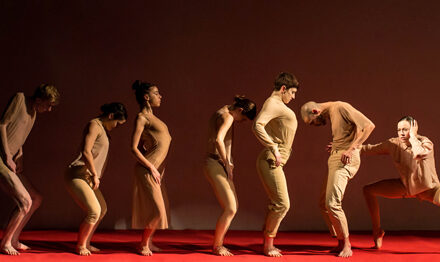The partnership of the Emerson String Quartet and Duke University goes back more than thirty years, including performances by offshoots of the ensemble as well as numerous appearances by the quartet itself. This concert was one of firsts and of renewal: Emerson’s debut at the recently renovated Baldwin Auditorium as well as their first concert at Duke with their new cellist, Paul Watkins. By presenting this concert, Duke Performances and the Chamber Arts Society have ensured that this longstanding relationship will continue to bring chamber music of the highest caliber to Triangle audiences.
When you see the names Mendelssohn, Shostakovich, and Beethoven combined on a program, there is the widest palette of emotional color that can be selected from that enormous cache of string quartets. This program had a distinct divide with the first half being decidedly on the far edge of darkness and despair and then with Beethoven slowly dragging us out of a depressive funk to joy and light.
Mendelssohn is usually portrayed as having a somewhat charmed though tragically brief life. Born into a family of financial means and influence, he at least escaped the mundane matters like how to pay for rent and food that many other musicians of his stature were cursed with. In addition to those providential gifts was his relationship with his sister Fanny, also a celebrated pianist and composer whom he adored.. When she suddenly died in May, 1847, during a rehearsal of one of her brother’s works, Felix was inconsolable. He traveled to Switzerland and spent much of his time painting. The pain of his sister’s death barely receded but he was finally able to compose his last major work: the String Quartet in F Minor, Op. 80.
A performance of this work is the equal of baring to a room full of strangers your most private and protected emotions, and the Emerson Quartet was up to that delicate task. Grief and despair doesn’t necessarily equal slow and quiet as demonstrated in the opening movement of this quartet. The Emersons propelled this rapid, angry, and defiant Allegro right out of the box and maintained an air of righteous despondency throughout. While it certainly is not unusual to have a movement with this character, it is nearly unprecedented to have a Classical or even Romantic period work remain as unrelenting as this in its bleakness, from start to finish. The forms of the movements remain standard, but gone is any resemblance to A Midsummer Night’s Dream or other carefree, youthful outlooks on life. However, this was just the warm-up for an even further descent into the distress of being human.
In 1969, hospitalized and pondering his mortality, Shostakovich penned his thirteenth string quartet, a one-movement, dark, and death-obsessed work. Dedicated to violist Vadim Borisovsky, this was indeed a showcase for Lawrence Dutton’s sensitive phrasing and burnished tone. The opening can be construed as a twelve-tone row, although those considerations tend to obscure average listeners’ concerns. Grating dissonances often live close to beautifully tonal counterpoint, and at times this seems like a compendium of 20th century effects. Shostakovich had always used his music as a sly, almost encrypted message to the Soviet powers who controlled his life and tried, but thankfully failed, to usurp his art. This is not an “easy listening” work, and to get its full effect and power you cannot be a passive listener. The Emerson Quartet imbued this performance with a masterly and mature touch. It required effort, but the rewards were great.
As mentioned earlier, this concert introduced our local audiences to cellist Paul Watkins, who replaced Emerson founder David Finckel in an amicable transfer of power. Formerly principal cellist of the BBC Symphony, prize winner of several competitions, and an accomplished conductor, the 43 year old Welshman more than ably takes over the cello duties. In joining violist Dutton and violinists Eugene Drucker and Philip Setzer, nothing really has changed: the two violinists swap first chair assignments, and except for Watkins, the group plays standing up. If anyone is looking here for a comparison between Finckel and Watkins or any nitpicking of Watkins’ playing, you have come to the wrong place!
Beethoven’s Fifth Symphony is universally acknowledged as the most popular symphony and possibly the “best” (whatever that may mean). Similarly, although not quite as unanimous, is the opinion that his String Quartet in F Major, Op. 59, No. 1, the first of the three “Rasoumovsky” quartets, is the “most popular” string quartet. The opening is like a great car engine starting up with that glorious cello line soaring above while we cruise down the highway. The work’s length and, for the time, revolutionary writing make it comparable to the “Eroica” Symphony, and in fact it is symphonic in scope. The scherzo has an almost ridiculous one-note theme which Beethoven expands to heavenly heights. The Emerson Quartet then played an achingly sad adagio that led, through a series of upwardly climbing trills, to a joyous and jubilant finale, based on a Russian theme.
If you are someone who likes to see a “show” when attending a string quartet concert, the Emerson Quartet is not for you. Both violinists are nearly statue-like and convey little, if any, emotion in their faces. Violist Dutton is a bit more emotive, while Watkins, perched on his platform, seems outwardly more engaged. But, these guys are not only at the top of their game, but at the apex of the string quartet as an art form. For those who felt that most of the concert tended towards the morose, the encore was a technically dazzling reading of the finale of the last of the three “Rasoumovsky” quartets. Played at a speed bordering on impossible, it was all done with a calmness and confidence that seemed unattainable to the mere mortals who heard them.











